Deciphering the mechanism of nano-enhanced docosahexaenoic acid accumulation in microalgae
IF 8.4
2区 工程技术
Q1 CHEMISTRY, MULTIDISCIPLINARY
引用次数: 0
Abstract
Docosahexaenoic acid (DHA) is a vital bioresource for human health due to its cardiovascular function, anti-inflammatory significance, and cognitive benefits. But the sustainability of DHA from its traditional sources is in question due to overfishing and environmental concerns. Microalgae is a sustainable alternative source of DHA; however, scale-up production of DHA from microalgae is strained due to the high cost of cultivation and extraction processes. This review provides an important insight into how nanoparticles can be used to enhance DHA biosynthesis in microalgae through targeted and efficient manipulation of cellular processes. The review shows that the manipulation of nanoscale material allows for intervention that improves the bioprospecting potential of microalgae through enhancing cultivation efficiency. Also, the mechanistic pathways through which nano-enhancement tends to upsurge DHA accumulation in microalgal systems were explored. The review indicates that nano-enhancements can be achieved through a complex mechanism that involves nanoparticles acting as growth promoters and biostimulants. Nanoparticles also enhance DHA in microalgae by triggering enhanced light utilization and plasmonic effects. Nanoparticles also play a critical role in increasing extraction efficiency and stability of DHA in microalgae, making them a promising tool for bioprospecting. But despite the significance of nanoparticles in enhancing DHA accumulation, limitations such as the high cost of nanomaterials and formulation, potential toxicity to microalgal cells, and limited understanding of nano-bio interactions hinder the achievement of scale-up application. Thus buttressing the need for further studies to address these challenges and optimize the use of nanoparticles in microalgae cultivation.
微藻纳米增强二十二碳六烯酸积累机制的破解
二十二碳六烯酸(DHA)具有心血管功能、抗炎作用和认知益处,是人类健康的重要生物资源。但是,由于过度捕捞和环境问题,传统来源的DHA的可持续性受到质疑。微藻是DHA的可持续替代来源;然而,由于培养和提取过程的高成本,从微藻中大规模生产DHA受到限制。这篇综述为纳米颗粒如何通过靶向和有效地操纵细胞过程来增强微藻中DHA的生物合成提供了重要的见解。研究表明,利用纳米材料进行干预可以提高微藻的培养效率,从而提高其生物勘探潜力。此外,还探讨了微藻系统中纳米增强倾向于增加DHA积累的机制途径。这一综述表明,纳米增强可以通过一个复杂的机制来实现,其中包括纳米颗粒作为生长促进剂和生物刺激剂。纳米颗粒还通过触发增强的光利用和等离子体效应来增强微藻中的DHA。纳米颗粒在提高微藻提取DHA的效率和稳定性方面也发挥着重要作用,是一种很有前景的生物勘探工具。但是,尽管纳米颗粒在促进DHA积累方面具有重要意义,但诸如纳米材料和配方的高成本、对微藻细胞的潜在毒性以及对纳米生物相互作用的有限理解等局限性阻碍了其大规模应用的实现。因此,需要进一步的研究来解决这些挑战并优化纳米颗粒在微藻培养中的应用。
本文章由计算机程序翻译,如有差异,请以英文原文为准。
求助全文
约1分钟内获得全文
求助全文
来源期刊

Journal of CO2 Utilization
CHEMISTRY, MULTIDISCIPLINARY-ENGINEERING, CHEMICAL
CiteScore
13.90
自引率
10.40%
发文量
406
审稿时长
2.8 months
期刊介绍:
The Journal of CO2 Utilization offers a single, multi-disciplinary, scholarly platform for the exchange of novel research in the field of CO2 re-use for scientists and engineers in chemicals, fuels and materials.
The emphasis is on the dissemination of leading-edge research from basic science to the development of new processes, technologies and applications.
The Journal of CO2 Utilization publishes original peer-reviewed research papers, reviews, and short communications, including experimental and theoretical work, and analytical models and simulations.
 求助内容:
求助内容: 应助结果提醒方式:
应助结果提醒方式:


